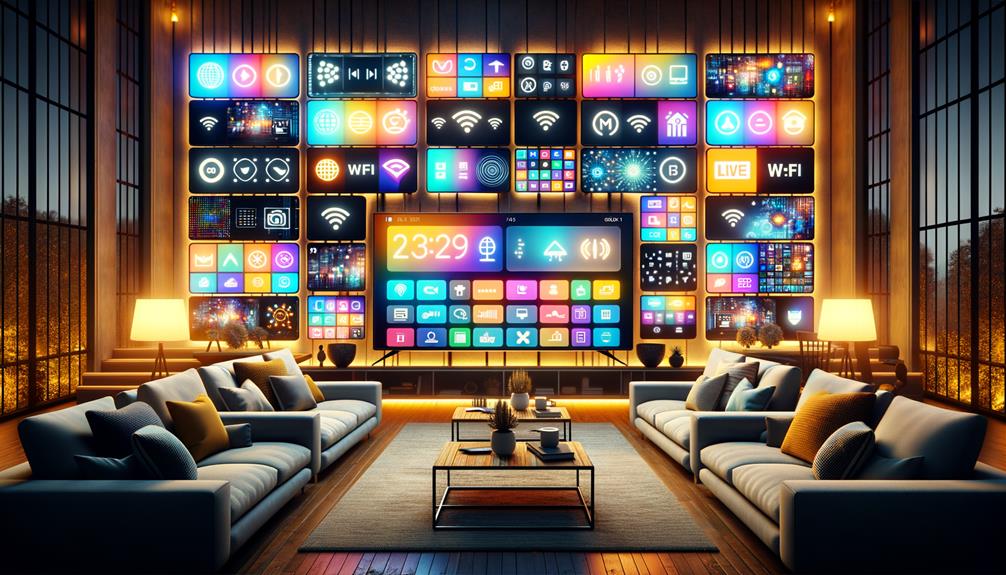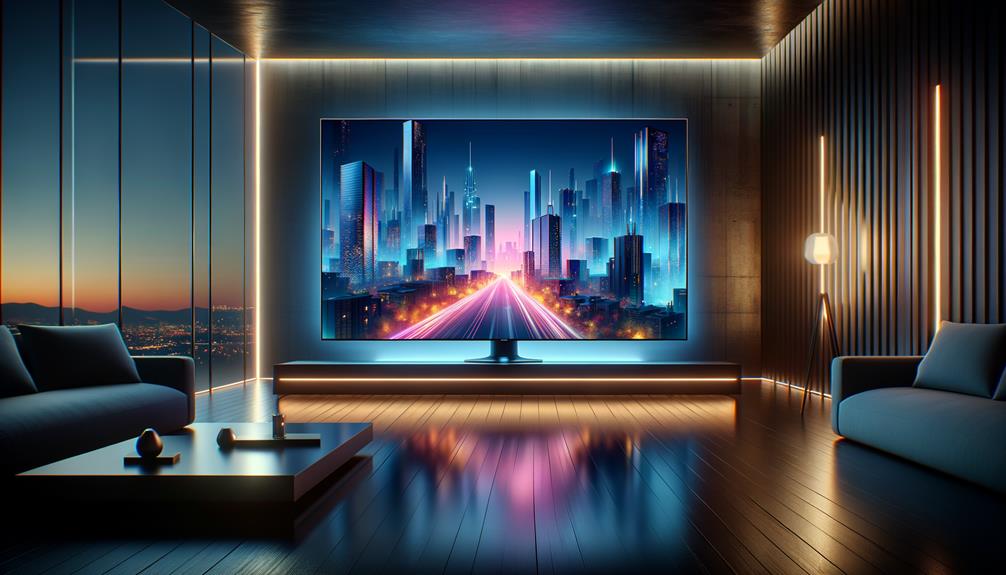
In the evolving TV market TV brands such as Samsung, LG, and Sony stand out with cutting-edge technologies tailored to augment user experience.
Samsung excels with its QLED and Neo QLED models, offering vibrant visuals, while LG is renowned for its OLED TVs, providing exceptional black levels and contrast.
Sony differentiates itself with advanced processing technologies that enhance image quality.
Innovations such as HDR10+ and Dolby Vision across these brands further refine picture quality, meeting diverse consumer preferences.
Moreover, these companies continue to innovate, integrating features like smart connectivity and voice control, enhancing interactive capabilities and overall user satisfaction.
Additional insights can further illuminate the distinctions between their high-end models and budget-friendly options.
Quick Summary
- Samsung, LG, and Sony are market leaders, offering advanced technologies in QLED, OLED, and superior processing capabilities.
- TCL and Hisense provide budget-friendly options with features like Roku OS and HDR10+.
- Innovations include HDR10+, Dolby Vision, and QD-OLED technologies enhancing visual performance.
- Premium models often integrate Dolby Atmos and smart platforms for immersive sound and seamless streaming.
- Connectivity features such as Wi-Fi, HDMI, and voice control enhance user experience in modern TVs.
Overview of Top TV Brands
Exploring the landscape of top TV brands reveals that Samsung, LG, and Sony dominate the market with their advanced technologies and user-centric features.
Market analysis indicates that Samsung leads with its diverse offerings like QLED and Neo QLED models, which are particularly favored in bright viewing environments.
LG’s prowess in OLED technology caters to users seeking unparalleled black levels and color accuracy, making its G3 series a popular choice.
Sony capitalises on its superior processing capabilities to enhance gaming and cinematic experiences, aligning closely with user preferences for high-performance multimedia.
These brands have strategically positioned their products to meet specific consumer demands, resulting in a robust market presence characterised by innovation and user satisfaction.
Innovations in TV Technology
Building on their strong market presence, leading TV brands continue to push the envelope with technological innovations that redefine viewer experiences.
The competition between OLED and QLED technologies is a focal point, with LG’s OLED offering unparalleled black levels and contrast, while Samsung’s QLED guarantees brighter visuals and vibrant colours.
The advancement in visual enhancements is also notable, with HDR10+ and Dolby Vision leading the way in dynamic range improvements.
These technologies allow for more detailed and lifelike pictures, enhancing the overall viewing experience.
| Brand | Technology | Visual Enhancement |
|---|---|---|
| LG | OLED | Dolby Vision |
| Samsung | QLED, Neo QLED | HDR10+ |
| Sony | QD-OLED | Dolby Vision |
| TCL | QLED | HDR10+ |
| Hisense | Standard LED | HDR10+ |
Comparing High-End Models

When evaluating high-end models from top TV brands, it’s important to take into account how features like OLED, QLED, and 8K resolution enhance overall performance and user experience.
These technologies not only offer sharper images and vibrant colours but also greatly improve gaming performance through faster refresh rates and lower input lag.
Key considerations include:
- Display Technologies:
Advanced OLED and QLED panels deliver exceptional contrast and colour accuracy, essential for both cinematic viewing and competitive gaming.
- Sound Quality:
Premium models often feature advanced audio technologies like Dolby Atmos, providing immersive sound that complements the visual experience.
- Smart Features:
Integration of smart platforms allows for seamless streaming and voice control, enhancing the functionality of high-end TVs in a connected home environment.
Budget-Friendly TV Options
While high-end TVs offer premium features, various brands provide budget-friendly options that deliver impressive performance and value for consumers with tighter budgets.
These brands have been compared based on key features and customer reviews to help guide potential buyers in making an informed choice. Below is a detailed comparison table:
| Brand | Key Features | Customer Reviews |
|---|---|---|
| TCL | Impressive picture quality | Highly rated for value |
| Hisense | Roku Smart TV OS, HDR10+ | Good balance of cost and quality |
| Roku TV | User-friendly OS, range of prices | Favorable for affordability |
| LG | Quality without compromise | Positive feedback on performance |
| Samsung | Sleek design, high-quality display | Well-received for style and function |
Each of these brands offers distinct advantages for those prioritising budget without sacrificing quality.
Smart Features and Connectivity

Smart TVs, equipped with an array of connectivity options such as HDMI and USB ports, along with innovative features like voice control and web browsing, have revolutionised the way users interact with their television sets.
Here are key elements contributing to their advanced capabilities:
- Wi-Fi Connectivity: Allows seamless access to streaming services, online gaming, and app interactions directly on the TV without the guarantee of wires.
- HDMI Advantages: Guarantees high-quality audio and video transmission from external devices, enhancing the overall multimedia experience.
- Voice Control Benefits: Simplifies the user interface, enabling efficient navigation and control through simple voice commands.
Screen mirroring options expand viewing possibilities by displaying content from mobile devices directly on the TV screen.
TV Viewing Experience Enhancements
Building on the advanced connectivity features of modern TVs, manufacturers have also greatly enhanced the visual and interactive elements to elevate the overall viewing experience.
Samsung’s QLED and Neo QLED technologies optimise colour accuracy and contrast ratios, making them ideal for bright environments.
LG’s OLED models excel in producing deep blacks and rich colors, enhancing viewer immersion.
Sony leverages its superior processing capabilities to guarantee smooth motion and effective sound optimisation, particularly benefiting PS5 gamers with its Google TV OS integration.
TCL and Hisense provide cost-effective solutions without compromising on quality; TCL’s QLED TVs and Hisense’s Roku-powered models both focus on maintaining high contrast ratios and effective ambient lighting adjustments to enhance the viewing experience.
Future Trends in Television

Advancements in television technology are set to transform the way viewers engage with media, featuring innovations such as Mini LED, QNED, and MicroLED that greatly enhance picture quality.
These developments not only promise superior visuals but are pivotal in the evolution of TV design aesthetics, shaping sleeker, more ambient devices that complement modern living spaces.
Significant trends include:
- Content Streaming Evolution: With smarter AI algorithms, televisions are advancing beyond traditional viewing, offering personalised content recommendations and integrating more seamlessly with various streaming platforms.
- Eco-Friendly Manufacturing: Emphasis on sustainability is driving the use of recyclable materials and energy-efficient designs.
- Immersive Technologies: Incorporation of AR and VR capabilities, enhancing the interactive experience and expanding the functionality of home entertainment systems.
Frequently Asked Questions
What Are Top 10 Brand TVs?
The leading television manufacturers, known for their advanced Smart TV features and high energy efficiency ratings, include Samsung, LG, Sony, Hisense, Panasonic, TCL, Vizio, Metz, Philips, and Toshiba.
Which Company Brand Is Best for TV?
Determining the best brand for televisions involves analysing brand reliability trends and future tech predictions. Samsung and LG lead in innovation, with OLED and QLED technologies setting standards in visual display quality.
What Are TV Brand Names?
Emerging brands in the television market complement established players through innovative brand evolution, enhancing consumer choice. Notable names include Samsung, LG, Sony, Hisense, and Panasonic, each offering unique technologies and user experiences.
Which Is the Best TV Brand in the Uk?
Determining the best brand involves analysing UK consumer preferences and regional market trends. Samsung, LG, and Sony lead due to advanced technologies and user satisfaction, each excelling in specific aspects like display and integration.
Conclusion
To sum up, the landscape of television technology is marked by rapid advancements and a diverse range of options catering to various consumer needs.
From cutting-edge high-end models showcasing the latest in display technology to budget-friendly options that still offer significant features and connectivity, the market remains robust and competitive.
Continued innovation, especially in smart features and enhanced viewing experiences, is anticipated to drive future trends, making televisions an integral component of modern digital ecosystems.
